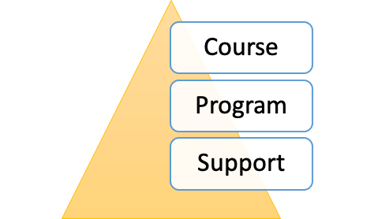Published on
The Importance of Intentional Online Program Design

The recent pivot to remote instruction as a result of the COVID-19 pandemic has highlighted the criticality of intentional program design. Unfortunately, the world’s health circumstances did not permit the time typically required to train faculty for effective online course design and delivery, develop course materials and set proper expectations for students.
There were a number of national and institutional surveys conducted to gauge students’ reactions to remote learning, and the results were generally consistent. For example, an EY-Parthenon student survey of remote learning conducted in April 2020 found that approximately 25% of students were dissatisfied with their remote learning experience. This was true across institutions of varying sizes, types and selectivity.
While it is certainly possible that some of this dissatisfaction is a result of students who had specifically chosen face-to-face classes being forced into an undesired modality, it is also true that–according to a different April survey conducted by Bay View Analytics (in partnership with five leading distance learning organizations)–97% of institutions reported assigning faculty with no prior online teaching experience to some of their remote courses. When we ask faculty to teach in an entirely new environment with no preparation in the midst of a global health crisis—and to do so for students who specifically chose not to learn in that context—it is unsurprising that so many students were dissatisfied.
What makes this remote experience different from (and arguably less successful than) an intentionally designed online learning experience is a lack of attention to the three primary dimensions of quality online education: course, program and support.

Course quality
Courses serve as curricular building blocks and represent the day-to-experiences of students and faculty. Over the past 25 years, researchers and practitioners have developed a corpus of knowledge around what constitutes a quality online course. This knowledge has been collected into processes and rubrics such as the OPEN SUNY OSCQR Course Design Review and the Quality Matters program and rubric. When applied to online course design, these peer-validated instruments can help ensure that students receive the highest quality experiences that research and practice can provide.
An established rubric helps faculty ensure that key elements such as interactivity, accessible/universal design, copyright compliance, mobile awareness, solid instructional design principles and many other criteria are included. Because of the rapid transition to remote learning, in many cases it was simply impossible to meet all of these course quality standards; however, intentionally designed online courses do.
One of the most important factors associated with a positive online learning experience is a predictable structure with clear expectations. For example, a course organized into one-week modules might require a weekly knowledge quiz to be completed within a week for each module. That way, busy, often non-traditional, students can plan their work accordingly. Unfortunately, the rapid transition to remote learning proved fundamentally disruptive to students and faculty alike, wreaking havoc on employment andchildcare. For many, predictability became difficult if not impossible to maintain.
Just as important as design is delivery. A well-designed course with an unresponsive faculty member, for example, will given students an overall poor experience. Most intentionally designed online courses are primarily asynchronous, specifically constructed to provide both temporal and geographic flexibility to non-traditional students. Yet, the spring 2020 migration to remote instruction relied primarily on the use of synchronous conferencing tools, such as Zoom and WebEx. While there are examples of high-quality synchronous online courses, they also require preparation and intentional design, dividing up presentations and activities, leveraging online tools such as whiteboards and breakout groups, and not simply lecturing for an hour or more at a time. But due to the lack of time to prepare, synchronous lecturing is exactly what the majority of faculty had to do.
Program quality
If courses are the curricular building blocks, the edifice they construct is the online curriculum, or program—whether that is a full degree or a certificate. Besides including fundamental components, such as an appropriate online scope and sequence and compliance with all accreditation requirements, an intentionally designed online curriculum will also consider a variety of programmatic elements.
One example resource for assessing an online program’s quality infrastructure is the Online Learning Consortium’s Quality Scorecard for the Administration of Online Programs. This scorecard helps institutions evaluate 70 different criteria across a set of categories like administration support, technology support, course development/instructional design, teaching and learning, faculty support, student support, and evaluation and assessment.
Although the spring 2020 transition to remote learning was primarily focused on courses, it is conceivable that many institutions were still lacking in many of these critical areas, especially if the institution and/or its faculty had little or no experience teaching online. In such a context, for example, there was likely inadequate faculty support to fully prepare faculty to teach online. It stands to reason that schools with established quality online program infrastructures were much better positioned to weather the rapid migration to remote learning than those that did not.
Support quality
Finally, the third critical element is the recognition that online students have particular challenges and require personalized support. Online students typically choose this modality because personal circumstances such as work or family necessitate maximum flexibility.
Excellent resources such as the Online Learning Consortium’s Quality Scorecard for Online Student Support, developed jointly by the State University System of Florida and the Florida College System, can offer institutions an instrument with which they can measure the effectiveness of their own online student support. Offering over 50 different criteria in categories such as admissions, financial aid, advising, veteran’s services, career counseling, orientation, library services, disability services, technology support and graduate student support, the OLC’s student support scorecard delineates the components necessary to helping students succeed in their online courses. Many schools go even further by employing full-time success coaches dedicated to online students.
Unfortunately, most of the students who were forced into remote learning in spring 2020 had no intention of learning online when they originally registered for those courses. They were likely never oriented to the online environment and were unaware of how to access the support services included in the scorecard, if the university even made them available for online students.
Colleges and universities that prioritize community likely never saw the need to invest in a robust online student support infrastructure. Unfortunately, when the pandemic struck, all of their students were forced into a remote learning reality, and their institutional support services offices had to scramble and improvise to serve them using unfamiliar tools and processes. It is no wonder that students in such a situation felt adrift, unsupported and dissatisfied.
Conclusion
That so many faculty and students were able to successfully migrate to remote learning is a testament to their creativity and grit. Now that we have faced the COVID-19 pandemic, we must learn from it and prepare for future waves of illness (coronavirus or other), natural disasters and other external forces that threaten to disrupt normal operations. In the 2020 Online College Students Report from Wiley Education Services and Aslanian Market Research, Wiley Education Services president Todd Zipper commented, “The radical shift to virtual learning during COVID-19, made possible by the heroic efforts of faculty, was critical to helping students continue their education, but should not be considered a true or sustainable online learning solution. The most successful online programs are carefully crafted by faculty and course designers who follow best practices for organizing courses, presenting content, empowering faculty and leveraging technology to encourage active engagement.”
There are myriad resources available to faculty and institutions to ensure that they are offering a quality online experience, should that again be necessary. We should take advantage of the luxury of time that we now have to put these elements in place. Compared to spring 2020, anything more than a week is a luxury.
Disclaimer: Embedded links in articles don’t represent author endorsement, but aim to provide readers with additional context and service.
References
EY-Parthenon Survey: https://www.parthenon.ey.com/po/en/perspectives/higher-education-and-covid-19-national-student-survey
Bay View Analytics Survey: http://onlinelearningsurvey.com/covid.html
Author Perspective: Administrator



